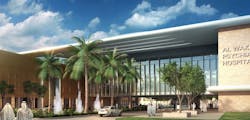Treating the whole person: Designing modern mental health facilities
Mental health issues no longer carry the stigma that they once did. Awareness campaigns and new research have helped bring our understanding of the brain—and how to design for its heath—into the 21st century. In recent years, the design industry has learned exactly how big an impact physical environments have on patient outcomes and staff productivity, especially in mental health facilities. We’ve moved away from solely focusing on seclusion, security and safety to designing welcoming, holistic environments that promote emotional, physical and psychological wellbeing. This means implementing biophilic practices, choosing patient-centered care as opposed to control-focused care and creating a healing space while still adopting the needed safety and security factors.
These trends have led to the idea of creating mental health facilities that resemble neighborhoods rather than sterile wards. Flexible care models allow hospital systems to provide connectivity and comfort for patients, while easing communication and wayfinding for visitors and staff. Centered around “main streets,” these neighborhoods promote interaction between patients, staff, visitors and family members, keeping individual wards from becoming isolated.
Of course, patient health and safety is still paramount. So while designing these welcoming facilities, we have to think about how to best ensure the facility’s security while maintaining the comfort and dignity of patients. This can be done through unobstructed and unrestricted sightlines.
One example of this approach is the CallisonRTKL-designed Al Wakra Psychiatric Hospital in Qatar. Using a neighborhood connectivity approached, CRTKL created a 65,000-SM space with 14 mental health wards and outpatient and inpatient pavilions that more closely resemble a community than a hospital.
Al Wakra’s “main street” unfolds to allow light to filter between the wards, and building blocks of the program are pulled apart to allow natural light. The team also introduced outdoor courtyards that provide patients with a space for reflection in a serene environment. The space acts as a non-institutional design solution that benefits all of its users in unique ways.
Paying homage to Qatar’s National Vision 2030, CallisonRTKL focused heavily on sustainability in the design of the hospital. Al Wakra aligns with Qatar’s goal of improving the health of the population by meeting the three facets of environmental, social and economic sustainability.
The result for the new Al Wakra Psychiatric Hospital combines aesthetics, performance and functionality while providing both staff and patients with personal, secure and non-institutional experiences.
Steve Stokes brings more than 25 years of comprehensive healthcare design and planning experience to the team. Throughout his career Steve has worked on conceptual design, building design, master planning and programming projects. His skill set lies in working with clients to achieve their built needs, while applying his attention to detail and his critical design eye to achieve the best outcome.
